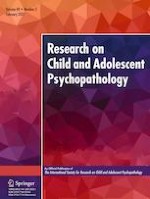15-10-2020
Parallel Trajectories of Proactive and Reactive Aggression in Middle Childhood and Their Outcomes in Early Adolescence
Gepubliceerd in: Research on Child and Adolescent Psychopathology | Uitgave 2/2021
Log in om toegang te krijgenAbstract
This study used an accelerated longitudinal design to investigate trajectories of proactive and reactive aggression in middle childhood and their outcomes in early adolescence. Children (N = 1420; ages 5–12; 48% female) were assessed biannually over 6 school years. Classroom teachers rated students’ proactive and reactive aggression throughout grades K-5; and multi-method (teacher-report, self-report, school records) measures of peer problems, depressive symptoms, academic performance, disciplinary actions, and school absenteeism were collected throughout grades 3–5. Latent class growth models were estimated to differentiate parallel-process trajectories of proactive-reactive aggression. Class membership was then examined as a predictor of outcomes at the end of 5th grade. The best-fitting solution had four trajectory classes: (1) low aggression, 76.7%; (2) high proactive-reactive aggression, 4.7%; (3) declining aggression, 4.9%; and (4) predominantly reactive aggression, 13.7%. Most classes showed seasonal upticks in aggressive behavior in the spring semester relative to fall; these were especially pronounced for proactive aggression, both as a variable and for the proactive-reactive class. Relative to their low-aggression peers, children in any elevated-aggression class had higher levels of peer problems, depressive symptoms, and disciplinary actions and lower GPAs at the end of 5th grade. The reactive class—which on no occasion had the highest total aggression—exhibited the most consistently unfavorable pattern of outcomes across methods and measures. Findings offer new insights concerning the multifinality and heterogeneity of aggressive behavior in childhood. Research, theory, and practice could benefit from adopting person-centered conceptualizations that consider the long-term trajectories, short-term variations, and proactive vs. reactive functions of youth aggression.
